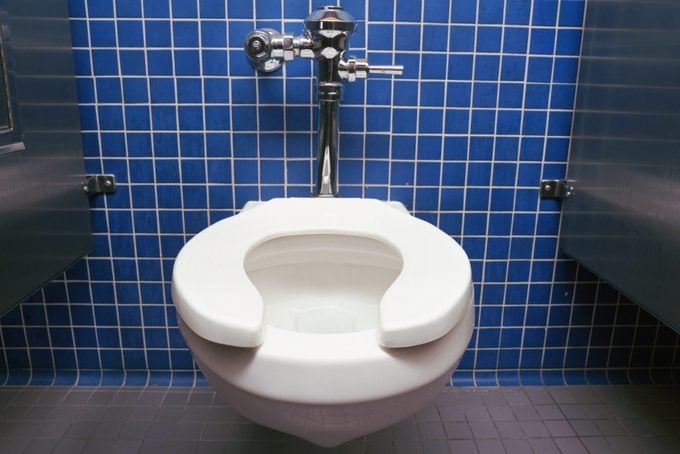Here’s Why It’s OK to Sit on a Public Toilet Seat
Updated: Nov. 08, 2023
Public toilet seats are repulsive to many people who worry about germs. But what does science suggest about sitting on a public toilet seat?
To sit or not to sit
The public toilet seat doesn’t exactly have a good reputation. In fact, many people will go to extremes to avoid sitting on one, or using public restrooms altogether.
But is there any real reason to avoid sitting on a public toilet seat? And are there any potential health risks or germs associated with methods used to avoid sitting on a public toilet seat, such as hovering, squatting, using toilet paper as a liner, or simply resisting the urge to go to the bathroom?
Here’s what the experts say about whether you should or should not sit on a public toilet seat.

Should you sit on a public toilet seat?
According to the experts, yes, you should sit on a public toilet when going to the bathroom. Despite their bad reputation, most public toilet seats don’t contain enough of the bacteria or other microbes that could harm you by being exposed to healthy skin.
And methods people use to avoid sitting on public seats, in particular hovering or holding it in, are toilet mistakes that can actually cause health problems.
David Coil, PhD, a microbiologist and project scientist at University of California-Davis, says when it comes to whether or not to sit on a public toilet seat, “Sit away!”
This Is the Only Stall You Should Use in a Public Bathroom
Can you catch anything from with sitting on a public toilet seat?
Stuart Reynolds, MD, MPH, FACS, an associate professor and fellowship director of the Female Pelvic Medicine & Reconstructive Surgery Unit at Vanderbilt University Medical Center in Nashville, says that for most people, there definitely is an “ick factor” when using public toilets.
Still, it is unlikely someone would catch an illness by sitting on a dirty toilet, especially if the toilet is just sprinkled with pee, rather than covered in poop.
“Pretty much all disease-causing organisms in urine can’t live outside the body or on hard surfaces and can’t be acquired by skin contact to your bottom,” Dr. Reynolds says.
Dr. Coil adds that maybe if you had open sores and sat on a dirty toilet seat there would be some small risk of catching disease, but even then the chances of transmission would be low.
That said, washed and unwashed toilet seats can certainly harbor bacteria, viruses, and fungi that could sicken you if you touched the toilet seat and then your mouth, eyes, or nose without washing your hands.
Research: Wash Your Hands Immediately After Touching These 10 Things
A 2017 study that tested 151 samples from public toilet seats, predominately hostels, found that the most common pathogens on the seats were E. coli, Salmonella, and Staphylococcus aureus.
But according to Dr. Coil, most microbes found on toilet seats and in bathrooms in general are the same microbes that we find associated with humans everywhere and do not typically cause disease.
“With the exception of some fecal and vaginal bacteria, most of what you’d find on a toilet is probably the same as what you’d find on your office desk: skin-associated bacteria,” he explains.
A 2019 study also found that many other parts of the toilet or items you interact with in public restrooms also contain potentially harmful bacteria, including toilet handles, flush-tank levers, and toilet paper.
It’s important to remember that nearly every surface you touch or interact with has plenty of microbes like bacteria, fungi, and viruses, most of which are not likely to cause health concerns. And in most cases, a toilet seat contains fewer bacteria than many other items we touch throughout the day, according to the Journal of Urology.
Experts add that most public toilet seats are also cleaned often, usually more frequently than your toilet seat at home. “The sponge in your kitchen probably has many times the number of microbes as a typical public toilet seat,” Dr. Coil says. “And the sponge isn’t particularly dangerous, either!”
Should you hover over a public toilet seat instead of sitting on it?
According to the experts, hovering over a toilet seat can interfere with urination by making it more difficult physically and not allowing for the proper flow of urine.
“The pelvic floor muscles are postural muscles,” says Stephanie Bobinger, PT, DPT, WCS, a physical therapist at the Ohio State University Wexner Medical Center. “It takes more energy and muscle activation around the pelvis to hover because one is supporting the body weight and balance; without optimal breathing habits, it can increase the effort for emptying and may not allow the full excursion of the pelvic floor to open and the urethra and bladder to empty.”
Bobinger says in general she does recommend sitting to give your body optimal alignment and muscle function.
While hovering over a toilet seat may interfere with proper urination, however, experts note this is normally only an issue if you do it often.
“In reality, hovering is likely only to be problem if you habitually urinate this way every time you go,” Dr. Reynolds says. “For those infrequent times when you have to hover in a public toilet, it is not likely to cause long-term problems.”
4 Yoga Poses To Strengthen the Pelvic Floor Muscles, From a Doctor of Physical Therapy
Hovering vs. squatting over a toilet seat
While many people think hovering is the same as squatting over a toilet seat, Dr. Reynolds says squatting is technically different from hovering.
“Squatting is thought to be highly effective for elimination, maybe more so [for] pooping than urinating, but still thought to be advantageous because of how the pelvic floor is relaxed and aligned,” he says.
Many companies now offer devices that allow you to comfortably squat while using the toilet, such as the famed Squatty Potty.
Here’s How Often You Should Have a Bowel Movement, Says a Gastroenterologist
Is it weird to hover over a public toilet seat?
According to experts, the research is becoming very clear: A large portion of people, in particular women, hover over a public toilet sit instead of sitting on it or avoid public restrooms altogether. In a 2020 study to which Reynolds contributed, 26% of women who were surveyed limited their use of public restrooms.
Among this segment of women, many reported using non-sitting positions, in particular hovering, and reported having lower urinary-tract conditions.
In the study, researchers found that cleanliness was one of the top reasons women avoided public restrooms or used what they call “unhealthy toilet behaviors” like hovering.
Bobinger adds that people may have their own past experiences and beliefs regarding use of public restrooms that may cause them to avoid public toilets or change their habits.
“Safety, how much time before able to get home or how long has it been since last void, concerns for any urinary leakage if [someone is] unable to hold to get to a different restroom, and history of frequent urinary infections or urinary retention [are] some of the concerns we hear in therapy,” she says.
10 Things Your Pee Reveals About Your Health
Should you hold it in instead of sitting on a public toilet seat?
Dr. Reynolds says the safety of “holding it” remains unclear. “In general, holding or delaying urination is thought to contribute to a number of problems. It can cause UTIs because emptying the bladder is a protective measure our bodies use to eliminate bacteria that might get in the bladder,” he says.
Dr. Reynolds says holding it in rather than using a public toilet can also cause discomfort or pain, anxiety or worry, and it might increase the risk of urine leakage or accidents.
“In the long term, habitual holding and infrequent voiding effectively trains your body and mind to ignore signals from your bladder, which can [cause] long-term problems for bladder health.”
He adds that of course, there is always the temptation to restrict how much you drink so you don’t have to go to the bathroom while in a public setting, but this habit can lead to dehydration, increase your risk of UTIs, and cause constipation, which in turn causes bladder problems and UTIs.
11 Things You Never Knew About Peeing
Long-term complications with hovering over a toilet seat or holding it in
“Regular use of a public toilet seat and occasional hovering or ‘holding’ are not going to cause any urinary or bladder issues,” Dr. Reynolds says. “It’s the long-term impacts of not using the toilet correctly, either hovering or holding, where we think issues arise.”
For instance, occupations where regular restroom access or use is restricted either because of lack of facilities or demands of the job can predispose workers to bladder issues, he explains.
Is it helpful to use a toilet-seat cover or tissue paper?

Remember those fold-out paper toilet-seat covers that used to be almost standard in public restrooms? Some of us may even remember a time when some public restrooms had a machine that would automatically use a conveyor-like system to dispose of previously used toilet seat covers that physically coated the toilet seat and replace it with a new one.
“In reality, a quick wipe-down of the seat, laying down toilet paper, or using a seat cover is plenty protection,” Dr. Reynolds says.
But other experts, such as Dr. Coil, recommend against trying to create your own toilet liner or wiping down the toilet seat before using it, noting that these methods might involve touching the toilet seat with your hands.
The 6 Worst Germ-Swapping Habits to Officially Stop Doing
Is there anything else to consider when using a public toilet?
The experts say research increasingly suggests that by far the most dangerous part of using a public toilet, or any toilet for that mater, is the plume of microbes released into the air when you flush it.
In a 2020 study, researchers reported that 40% to 60% of viruses found in toilet contents were propelled upward beyond the toilet seat into the air, resulting in wide viral spread. They also found that virus particles released by the process of the toilet flushing can travel more than 3 feet upward and linger in the air for more than a minute.
The coronavirus SARS-CoV-2 can be found in the feces of someone with Covid-19, even after the person recovers. But experts say it’s still unclear whether there would be enough viral particles in a toilet plume for someone to develop Covid-19, or whether enough of the viral particles can land on the toilet seat to cause infection if you touched it and then touched your mouth, nose, or eyes.



















